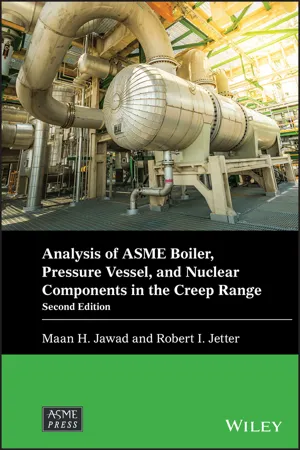
Analysis of ASME Boiler, Pressure Vessel, and Nuclear Components in the Creep Range
- English
- PDF
- Available on iOS & Android
Analysis of ASME Boiler, Pressure Vessel, and Nuclear Components in the Creep Range
About this book
Analysis of ASME Boiler, Pressure Vessel, and Nuclear Components in the Creep Range
Second Edition
The latest edition of the leading resource on elevated temperature design
In the newly revised Second Edition of Analysis of ASME Boiler, Pressure Vessel, and Nuclear Components in the Creep Range, a team of distinguished engineers delivers an authoritative introduction to the principles of design at elevated temperatures. The authors draw on over 50 years of experience, explaining the methodology for accomplishing a safe and economical design for boiler and pressure vessel components operating at high temperatures. The text includes extensive references, offering the reader the opportunity to further their understanding of the subject.
In this latest edition, each chapter has been updated and two brand-new chapters added—the first is Creep Analysis Using the Remaining Life Method, and the second is Requirements for Nuclear Components. Numerous examples are included to illustrate the practical application of the presented design and analysis methods. It also offers:
- A thorough introduction to creep-fatigue analysis of pressure vessel components using the concept of load-controlled and strain-deformation controlled limits
- An introduction to the creep requirements in API 579/ASME FFS-1 "Remaining Life Method"
- A summary of creep-fatigue analysis requirements in nuclear components
- Detailed procedure for designing cylindrical and spherical components of boilers and pressure vessels due to axial and external pressure in the creep regime
- A section on using finite element analysis to approximate fatigue in structural members in tension and bending
Perfect for mechanical engineers and researchers working in mechanical engineering, Analysis of ASME Boiler, Pressure Vessel, and Nuclear Components in the Creep Range will also earn a place in the libraries of graduate students studying mechanical engineering, technical staff in industry, and industry analysts and researchers.
Frequently asked questions
- Essential is ideal for learners and professionals who enjoy exploring a wide range of subjects. Access the Essential Library with 800,000+ trusted titles and best-sellers across business, personal growth, and the humanities. Includes unlimited reading time and Standard Read Aloud voice.
- Complete: Perfect for advanced learners and researchers needing full, unrestricted access. Unlock 1.4M+ books across hundreds of subjects, including academic and specialized titles. The Complete Plan also includes advanced features like Premium Read Aloud and Research Assistant.
Please note we cannot support devices running on iOS 13 and Android 7 or earlier. Learn more about using the app.
Information
Table of contents
- Analysis of ASME Boiler, Pressure Vessel, and Nuclear Components in the Creep Range
- Contents
- Preface
- Acknowledgement for the Original Edition
- Acknowledgement for this Edition
- Abbreviations for Organizations
- 1 Basic Concepts
- 2 Axially Loaded Structural Members
- 3 Structural Members in Bending
- 4 Analysis of ASME Pressure Vessel Components: Load-Controlled Limits
- 5 Analysis of Components: Strain and Deformation-Controlled Limits
- 6 Creep-Fatigue Analysis
- 7 Creep-Fatigue Analysis Using the Remaining Life Method
- 8 Nuclear Components Operating in the Creep Regime
- 9 Members in Compression
- Appendix A: ASME VIII-2 Supplemental Rules for Creep Analysis
- Appendix B: Equations for Average Isochronous Stress-Strain Curves
- Appendix C: Equations for Tangent Modulus, Et
- Appendix D: Background of the Bree Diagram
- Appendix E: Factors for the Remaining Life Method
- Appendix F: Conversion Factors
- References
- Bibliography of Some Publications Related to Creep in Addition to Those Cited in the References
- Index
- EULA